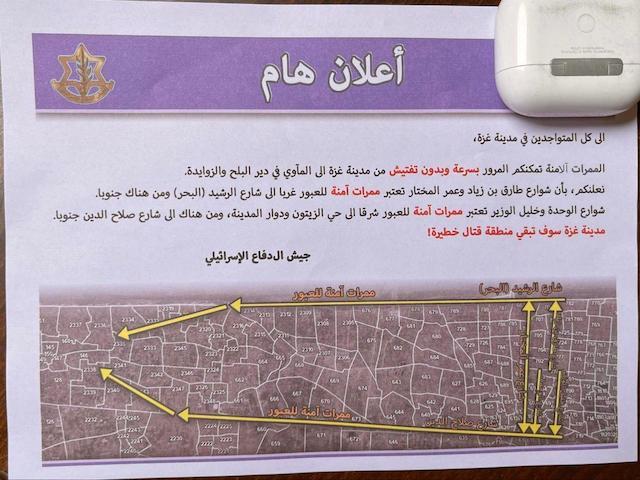In a significant development, the Israeli military has issued a sweeping evacuation order for Gaza City, a focal point of the ongoing conflict, as the region witnesses a surge in hostilities. This directive marks a potential escalation of Israel's military operations within the densely populated urban center just months after it pulled out of the Strip's largest urban area. The order demonstrates how Hamas has been rebuilding their capabilities in the center of the enclave.
Evacuation Alert
On Wednesday, the Israeli Defense Forces (IDF) disseminated leaflets across Gaza City, urging residents to relocate to the southern regions. The leaflets starkly warned, "Gaza City will remain a dangerous combat zone," signaling the intensification of military actions in the area. This move could indicate Israel's strategic expansion into the city, where its forces have been active in peripheral neighborhoods recently.
The Gazans are leaving Gaza City and going south in increasing numbers. In this video, the IDF is calling them and handing them water bottles, and at the end of the video, they tell them in Arabic, "Look what Hamas did to you..." pic.twitter.com/b3HH5tspc9
— Raylan Givens (@JewishWarrior13) July 10, 2024
Renewed Clashes and Civilian Impact
The latest developments underscore a troubling pattern of Hamas regrouping in territories previously declared clear by Israeli forces. On the same day, Israeli airstrikes tragically claimed the lives of 20 Palestinians in central Gaza, including six children and three women, some of whom were within an Israeli-designated "safe zone." Hospital authorities reported the casualties, reflecting the persistent danger faced by civilians amidst the conflict.
Diplomatic Efforts for Ceasefire
Amid the relentless violence, diplomatic endeavors are ongoing in Doha, Qatar, involving U.S., Egyptian, and Qatari mediators alongside Israeli representatives. These discussions aim to broker a long-sought ceasefire and facilitate the release of hostages. Although progress has been made, significant hurdles remain.
Central Gaza Tragedy
In the early hours of Wednesday, Israeli strikes targeted three homes in the Nuseirat refugee camp, resulting in 12 fatalities, including five children. An Associated Press correspondent on the scene verified the death toll. This camp, originally established for Palestinians displaced during the 1948 war, has evolved into a dense urban enclave.
The IDF called on the residents of Gaza city to evacuate to the center camps: "Became a dangerous combat zone".
— Shiri_Sabra (@sabra_the) July 10, 2024
-N12 pic.twitter.com/ofj4sFfgXl
Deadly Strikes in Deir al-Balah
Another strike in Deir al-Balah, within the so-called "humanitarian safe zone," killed four men, three women, and a child. This area was designated by Israel as a refuge for Palestinians amidst the broader offensive operations across Gaza.
UNRWA School Attack
Adding to the devastation, Israeli warplanes targeted an UNRWA school being used by Hamas that was also sheltering displaced families in Gaza City near Khan Younis. Nasser Hospital officials confirmed over 30 casualties but there is no confirmation on these numbers or how many were militants vs. civilians. The IDF stated that the airstrike, aimed at a Hamas militant involved in the October 7th attack on Israel, is under review amid reports of civilian casualties. Israel has been credited by Urban Warfare experts for having one of the lowest civilian to militant death rates in modern history at an estimated 1.5 civilians killed for each militant.
Overnight, the IDF conducted a counterterrorism operation against Hamas and Islamic Jihad terrorists operating inside @UNRWA's Headquarters in Gaza City.
The UN has never acknowledged Hamas and Islamic Jihad operating out of its buildings. pic.twitter.com/Non71nvozc
— Eylon Levy (@EylonALevy) July 10, 2024
Historical Context and Accountability
The recent surge in Israeli military actions follows the horrific cross-border raid by Hamas on October 7th, which resulted in the deaths of 1,200 Israelis, predominantly civilians, and the abduction of approximately 250 people. According to Israeli authorities, about 116 hostages remain in captivity, with an estimated third presumed dead.
The IDF emphasizes that civilian casualties stem from Hamas's strategy of embedding militants within densely populated urban zones. While the military seldom elaborates on specific strike targets unless acknowledging errors, it maintains a stance of accountability for operational mistakes.
As the conflict persists, the international community watches closely, hoping for a resolution that prioritizes civilian safety and paves the way for a sustainable ceasefire.


